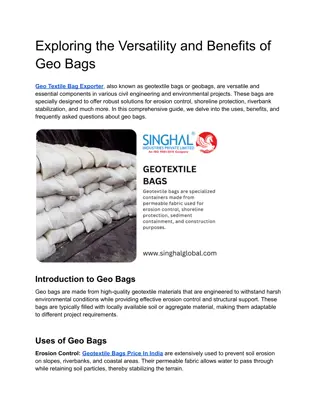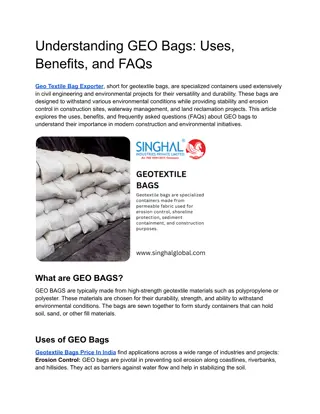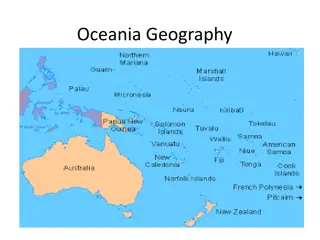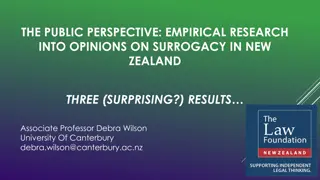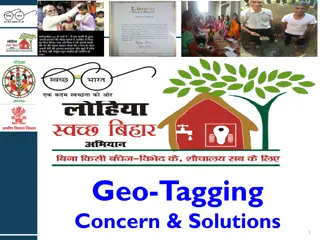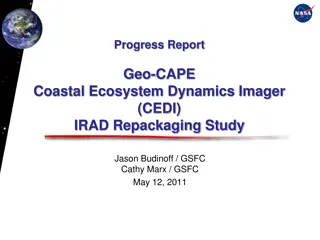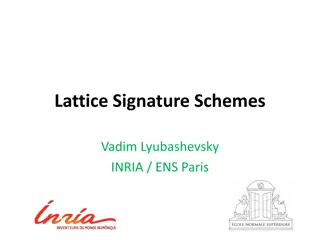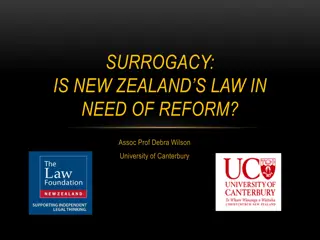Implications of Geo-Engineering Schemes for New Zealand: Policy Development
Exploring the scientific, technical, and geopolitical aspects of geo-engineering schemes and their implications for New Zealand's policy development. Discusses the current legal and policy constraints, international regulations, and the future of regulating geo-engineering technologies in the context of existing frameworks and treaties.
Download Presentation

Please find below an Image/Link to download the presentation.
The content on the website is provided AS IS for your information and personal use only. It may not be sold, licensed, or shared on other websites without obtaining consent from the author.If you encounter any issues during the download, it is possible that the publisher has removed the file from their server.
You are allowed to download the files provided on this website for personal or commercial use, subject to the condition that they are used lawfully. All files are the property of their respective owners.
The content on the website is provided AS IS for your information and personal use only. It may not be sold, licensed, or shared on other websites without obtaining consent from the author.
E N D
Presentation Transcript
SCIENTIFIC, TECHNICAL AND GEOPOLITICAL ASPECTS OF GEO-ENGINEERING SCHEMES: IMPLICATIONS FOR NEW ZEALAND Development of Policy on Geo- engineering
Geo-engineering as a Law & Policy Issue From (Lunatic) Fringe... ...To Mainstream Science
Geo-engineering as a Law & Policy Issue The Present... The Future... Current legal and policy constraints on the development of geo- engineering technologies. How should geo-engineering technologies be managed in the future?
Discussion: Existing Legal & Policy Constraints Does current international law regulate or have implications for the development of geo- engineering technologies? There is little direct regulation of geo-engineering activities with the exception of: Forestry projects, which are subject to rules established by the 1992 UNFCCC and the 1997 Kyoto Protocol; Sequestration of CO2under the seabed, which is subject to the 1996 Protocol to the 1972 London (Dumping) Convention; Ocean fertilization projects at the research stage, which are currently under consideration by the parties to the 1996 Protocol to the 1972 London (Dumping) Convention.
Discussion: Existing Legal & Policy Constraints However, New Zealand has ratified a large number of international treaties and is bound by principles of customary law relating to environmental protection and the conduct of scientific research. These rules may directly or indirectly have implications for the development of geo- engineering technologies. E.g. 1982 UNCLOS 1992 CBD 1979 CMS 1992 UNFCCC 1972 London Convention & 1996 Protocol Precautionary Principle?
Discussion: The Future of Regulation Selected Questions 1. Are geo-engineering technologies qualitatively different from other technologies associated with climate change and, as a consequence, require the development of specialist principles or approaches to regulation? Or, are our existing regulatory tools sufficient?
Discussion: The Future of Regulation Selected Questions 2. How can we effectively manage geo-engineering technologies in the face of significant scientific uncertainty? Does the precautionary principle have a role to play or would it simple stifle all research and innovation?
Discussion: The Future of Regulation Selected Questions 3. Who gets to decide whether to engineer the planet to solve climate change? Individual states? A collective decision? An expert decision?
Discussion: The Future of Regulation Selected Questions 4. Should decisions to develop geo-engineering technologies be made on a case-by-case basis or should their be some form of overall control at the macro level? Do we have appropriate institutions at a national & international level to enable us to achieve this?
Discussion: The Future of Regulation Selected Questions 5. What (if any) role should private corporations and individuals play in the decision to engineer the planet? Should corporations be permitted to profit from geo-engineering technologies?
Discussion: The Future of Regulation Selected Questions 6. Can we prevent the abuse of climate modification technologies for hostile purposes? Is the 1977 Convention on the Prohibition of Military or Any Other Hostile Use of Environmental Modification Techniques fit for twenty-first century purpose?
Discussion: The Future of Regulation Selected Questions 7. What is the relationship between engineered technological options and other solutions such as mitigation and emissions reductions? Should geo-engineering technologies be included in the Kyoto CDM/ JI mechanisms?
Discussion: The Future of Regulation Selected Questions 8. Should we apply, and if so, how do we apply the concepts of state responsibility and individual liability for harm caused by deliberately induced climate modification?
Regulating Geo-engineering: Management Options 1. Voluntary Guidelines 2. Ad hoc regulation by existing bodies and regimes Eg IMO and UN Committee on the Peaceful Uses of Outer Space 3. International Convention on Geo-engineering 4. Protocol to the 1992 UNFCCC
Proposed Geo-engineering Protocol to the 1992 UNFCCC 1992 UNFCCC Policy; general principles, co- ordination; relationship with other climate change measures Protocol on Geo-engineering 1997 Kyoto Protocol IMO UN Committee on Peaceful Uses of Outer Space 1996 LP Fertilization Pipes and other equipment Co-ordinate with UNGA; UNCLOS; UNEP, OSPAR, etc.






